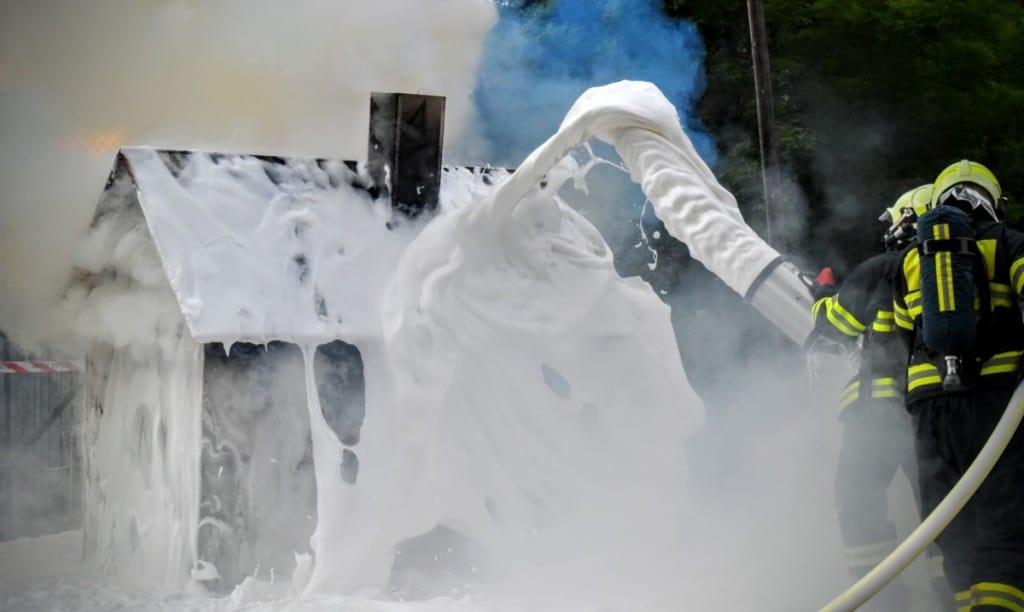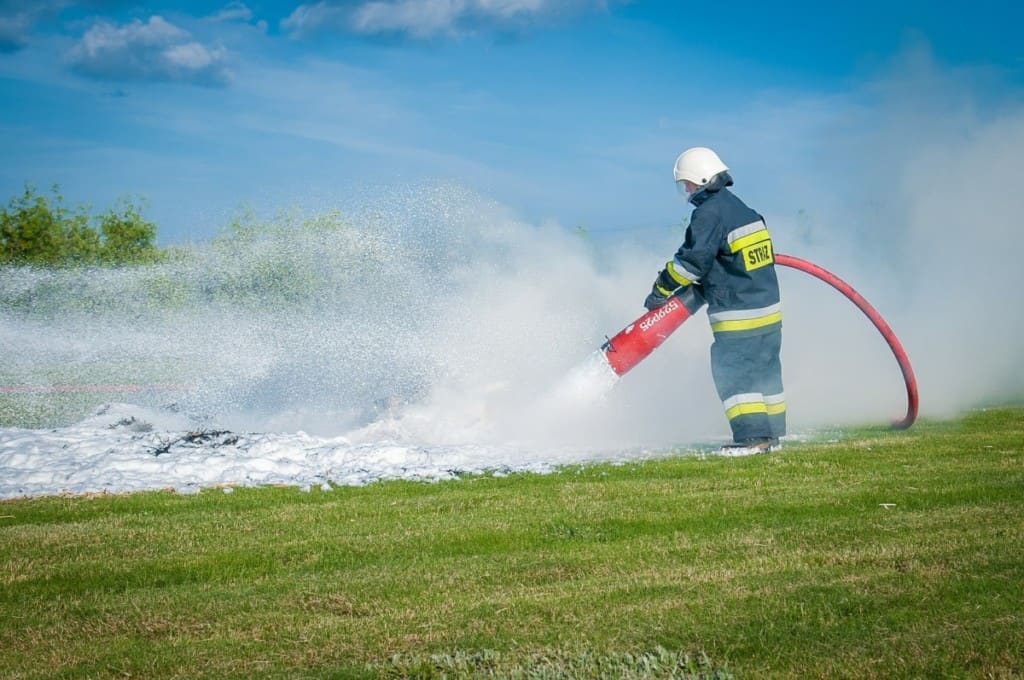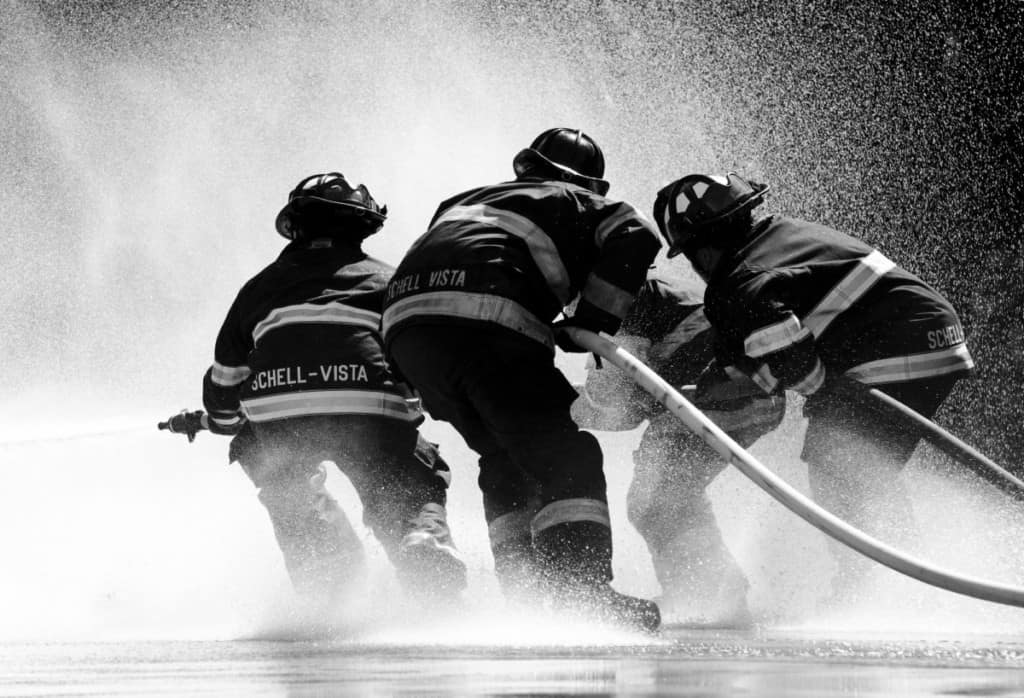When most people think about firefighters extinguishing a fire, most people assume that firefighters always use water. However, water isn’t the only material firefighters use to fight fires. They also use other substances, including foam.
Firefighting foam is used instead of water for certain types of fires. There are two types of firefighting foam: Class A and Class B. Class A is used on ordinary combustibles to reduce the surface tension of the water, which better saturates the fuel, and Class B is used on flammable liquid fires.
In this article, we’ll discuss in-depth exactly why firefighters use foam, the different types of foams, when firefighters will use each type of foam, and more.
Your # 1 priority is keeping your family safe. As a firefighter, I recommend everyone has updated smoke detectors that don’t require battery changes, like these ones from Kidde, a fire extinguisher, like this one from Amerex, and a fire escape ladder if you have bedrooms above the first floor, I recommend this one from Hausse.
To learn about all the other ways firefighters put out fires, read: What Do Firefighters Use to Put Out a Fire?
Firefighting Foam
Before fighting any fire, it’s essential to understand the chemistry and science behind fire and what makes it burn. Any flame, regardless of size, requires three elements to survive:
- Heat
- Fuel
- Oxygen
These simple ingredients form a flame that burns for eternity until one element is removed or depleted. These 3 elements make up what is called “The Fire Triangle.”
For more information on the Fire Triangle, Read this article and this article.
This equation is best visualized by a campfire burning away. The wooden logs act as fuel. The air (which contains oxygen) fans the flames as it is blowing through. Then, there’s the heat trapped between the logs.
How can a campfire be extinguished? Removing the oxygen would starve the flames, and therefore put out the fire. This is what happens when the fire is contained in a closed space and uses all the oxygen or if the oxygen is displaced by another gas like carbon dioxide. This is why the fire goes out when you cover it with sand or dirt.
We could also remove the logs or fuel from the fire; the very fuel it needs to survive. This method would also extinguish the flames, though it may take a while if there are coals still burning.
Or we can remove the heat. One of the most effective ways to remove heat is, you guessed it, water. Dousing the flames with a sufficient amount of water will cool it until it’s out. The fire may sizzle in the beginning, turning the first few drops into steam, but as more water is poured, the flames would disappear as the water reduces the heat.
However, not every fire’s fuel source is timber, and that’s where things take a turn.
The same three elements mentioned before also produce an oil fire. The oil (which is the fuel) is heated to a combustible temperature, which is known as a flash point.
Spraying water on this type of fire would have a dangerously detrimental effect: the flames would spread as the oil floats on the water’s surface. The water would then turn to steam and accumulate beneath the oil’s surface, which may result in an explosion.
Firefighters discovered that to successfully extinguish an oil fire, removing the oxygen is the best course of action.
But how do you remove the oxygen from a raging oil fire? Sealing the doors to remove some of the oxygen may reduce the ferocity of the flames, but it won’t put out the fire entirely. And you can’t exactly suck the oxygen out of the room; Earth’s atmosphere is far too oxygen-rich for that option to work.
The answer is firefighting foam, which was invented in 1902 by Aleksandr Loran, a Russian chemist and engineer who lived in the city of Baku. Loran witnessed unimaginable oil fires because of the city’s thriving oil industry, and so he tried to find a solution to the problem.
Loran discovered that by placing an impenetrable layer between the surface of the fuel source and the oxygen, oil fires could be extinguished. He then invented this layer by creating firefighting foam. The foam cooled the fuel source enough to prevent reignition and, at the same time, deprive the fire of oxygen.
Loran patented the firefighting foam in 1904. He also developed the first foam fire extinguishers and sold them under his company, Eurica. From these humble beginnings, firefighting foam began to be worked on extensively by scientists, resulting in the wide array of foams we have today.
History and Evolution

The first fire extinguisher evolved into a product that could be used in a wide variety of situations. Loran’s original foam extinguisher used powdered forms of sodium bicarbonate and aluminum sulfate mixed with water. They were deemed effective in their day but are now seen as obsolete because of the vast quantities of powder required to extinguish even small fires.
It wasn’t until the 1940s when Percy Julian improved Loran’s formula and developed an enhanced version called “Aerofoam.” Julian’s product was created through a mechanical process by mixing soy protein with water through an aerating nozzle to form foam. The product’s improved expansion ratio, as well as the simpler handling method, made it a more popular choice.
However, Aerofoam had a downside – other flammable liquids can contaminate it. Hence, firefighters needed to ensure the foam was only applied above the surface of the burning liquid to prevent losing its effectiveness.
Herbert Eisner, an English mining researcher, conceived the first high-expansion foam in the 1950s. It was used to fight coal mine fires.
Will Jamison, a US mining engineer, further developed the formula of high-expansion foam after reading about in a journal. Together with the US Bureau of Mines, he tested over 400 different formulas before finding a suitable compound. In 1964, Walter Kidde purchased the patents for high-expansion foam.
Despite these developments, a common problem remained. Contamination of the foam by some liquids still rendered the foam ineffective.
National Foam Inc. developed a solution in the 1960s called fluoroprotein foam. Not only did this new foam have superior oil-rejecting properties, but it also had a longer blanket life. These features created a safer environment when rescuers were required to go inside a burning structure.
The foam had fast knockdown characteristics compared with all previous foams and can be used in conjunction with dry chemicals that are known to destroy protein foam.
But the US Navy needed something more and began to create its own foam for fighting fires. In the mid-1960s, it developed aqueous film-forming foam (AFFF). AFFF was a synthetic foam with very low viscosity, and it can spread rapidly across the fuel’s surface. The foam could also be used on most hydrocarbon fires, as water film develops beneath the foam, stopping flammable fuel vapors by cooling the liquid fuel.
AFFF’s capability to knock down the fire quickly made it a popular choice in crash rescue fires.
With the base foam now developed into a formidable firefighting weapon, the call went out for more specialized variations that could be used on specific types of fires. Also, as firefighting techniques improved with technology, different types of fires were identified and classified. This classification of fires significantly aided in the safety of extinguishing them.
Although, something to keep in mind is that some types of firefighting foam have been found to be potentially hazardous to humans.
Also read: How Much Water Does A Fire Truck/Fire Engine Hold?
Classes of Fires
In the United States, fires are classified into one of five categories (six in some countries). The classification is based on the type of fuel the fire is consuming and the suppression method most suitable to extinguish it.
Class A
This class of fire involves combustible materials such as wood, paper, fabric, and standard refuse. These are known as ordinary combustibles. These types of fires are the simplest to deal with. They can be extinguished using most suppression methods, including water, wet chemicals, and dry powders.
Class B
This class of fire contains all flammable liquids and gases. Some countries classify flammable gases as a separate category.
Water should never be used on these fires as it can scatter the flames rather than extinguish them. The most suitable suppression method is one that inhibits the chemical’s chain reaction, which is dry chemical suppression.
Class C
This class of fire covers electrical hazards. It can be any type of fuel burning, but with energized electrical issues as well. Class C fires can cause electrocution if proper methods are not used to extinguish.
These types of fires are best suppressed using dry chemical extinguishers or Carbon Dioxide. If the power source can be removed, then the fire can be suppressed with water in the same way as Class A or B fires.
Class D
Flammable metals such as lithium, potassium, magnesium, and titanium are under Class D fires. These types of fires pose a much higher risk because the public is not familiar with metal’s properties and may not be able to handle them properly.
Extreme caution should be used when dealing with metallic fires as water tends to increase their ferocity instead of suppressing them. The most effective suppression method is to smother the fire with a dry chemical powder, specifically designed for flammable metal fires, which cools the fuel source.
Class K
Cooking oils and fats, although technically under Class B fires, are deemed worthy of having their own class because of their specific characteristics. Found mainly in commercial kitchens, the fuel source is mostly unsaturated cooking oils with a much higher flash point than other flammable liquids.
Class K fire extinguishers use a special type of dry powder that turns the fuel source into foam, thereby smothering the flames from the bottom up. This process is called saponification.
As you can see from the descriptions, many classes of fire require a dry chemical application to be effectively extinguished. Only the first two classes – Class A and Class B – can be put out using foam.
Note: For the classes of fires in your specific country, please click here.
Fire Foam Types

As mentioned in the introduction, there are two types of foams: Class A foams and Class B foams. Class A foams are used to fight Class A fires, and Class B foams are used to fight Class B fires.
- Class A foams are used to lessen the surface tension of water, which improves the wetting and saturation of water used to fight Class A fires, which are fueled by ordinary combustibles.
- Class B foams are used to fight Class B fires, which are fueled by flammable liquids.
However, there is much more nuance and differentiation between subcategories of these classes than the simple separation into “Class A” and “Class B” might lead you to believe.
For starters, different types of foam have different expansion rates, which indicates how large the foam will get after the initial spray. There are also a variety of mechanical foam concentrates, all of which we’ll discuss in a bit.
Anyway, let’s pick up where we left off with, with the fact that different types of fires classified were into various categories.
As a result of this classification, firefighting foams were then classified into different groups as well. Early foams would fall into one of three subclasses, each class reflecting the foam’s expansion ratio.
Knowing the expansion ratio of the foam is critical when fighting different fires. The formula for the expansion ratio is the volume of finished foam divided by the initial foam solution. If 1 gallon of foam solution turned into 5 gallons of actual foam once fired, then the solution has an expansion ratio of 5:1.
The categories of firefighting foam are:
- Low expansion ratio – Foam that has an expansion ratio between 2:1 and 20:1
- Medium expansion ratio – Foam that has an expansion ratio between 20:1 and 200:1
- High expansion ratio – Foam that has an expansion ratio above 200:1
Before determining which firefighting foam is suitable for which fire, one must know what flammable fuel is fanning the flames. Flammable liquids fall into one of two categories:
- Standard hydrocarbon fuels, such as jet fuel, gasoline, and diesel. These fuels do not mix with water and will float to the surface if exposed to water.
- Polar solvent or alcohol-type fuels mix and disperse in water.
Firefighters must know which type of fuel they are dealing with, as some firefighting foams are not suitable for polar solvent or alcohol-type spills.
To gain an understanding of the sheer number of choices available to modern firefighters, we must know the different mechanical foam concentrates most commonly used in today’s world. These include:
- Aqueous film-forming foam (AFFF) – This foam forms an aqueous film on the surface of the flammable liquid. It suppresses the fire by interrupting the vapors feeding it. AFFF has an unmatched speed in fire control because of this film.
- Alcohol-resistant AFFF (AR-AFFF) – AR-AFFF is a foam designed to remedy the weakness of AFFF against polar solvent or alcohol-type fires. Because polar solvents/alcohols mix with water, they break down and destroy AFFF blankets with ease. AR-AFFF has an extra polymer added to its base concentrate that precipitates a physical membrane/barrier between the fuel source and the foam blanket.
- Synthetic foams (detergent) – These foams are medium- or high-expansion types. They are used primarily in places where volume fire control is needed, such as a mineshaft, ship’s hold, or basement. Medium- or high-expansion synthetics can be used to quickly fill an entire compartment with very light, expanded foam bubbles. These synthetics can reach ratios of as much as 1000:1.
- Class A foam concentrates – A small amount of Class A concentrate can increase the effectiveness of water as much as five times. It can cling to vertical and horizontal surfaces without run-off.
- Wetting agent – The effectiveness of this type of foam is similar to that of Class A but without the foaming abilities.
- Fluoroprotein – Fluoroprotein is more resistant to fuel contamination, making it perfect for fires in storage tanks holding hydrocarbons. The foam can be injected directly into the base of the tank, where it will float to the surface unimpeded and will blanket the surface flames.
- Protein – Protein will produce a highly stabilized air foam. However, because flammable liquids can contaminate it, care needs to be taken when applying the foam. Protein-based foams should be sprayed as gently as possible.
- Film-forming fluoroprotein (FFFP) – A derivative of AFFF and fluoroprotein, this foam was developed to provide the quick knockdown capabilities of AFFF but with added burn-back resistance.
All the above foam concentrates have been deemed safe for use with fresh water, seawater, and brackish water. They are designed to provide the best possible options for firefighters when tackling hazardous fires.
Conclusion
Given the amount of information available about the various types of foams that have been developed since Loran started way back in 1902, you can see the complexity of firefighting in today’s world. With the ever-increasing needs of the growing population, combined with an endless introduction of new technology, you can only imagine what the future holds for the firefighters of tomorrow.
Firefighters use every available tool at their disposal. Foam, developed throughout the years by dedicated individuals, is now at the forefront of this battle. It began as nothing more than a mixture of water, foam concentrate, and air, designed to combine into a homogenous foam blanket when mixed in correct proportions.
Who would have thought that, aside from water, a simple mass of bubbles can put out a fire?
Related Articles
8 Ways To Find The Nearest Fire Hydrant
What’s the Difference Between a Fire Engine and a Fire Truck?

